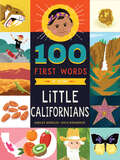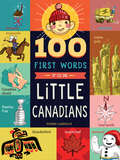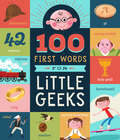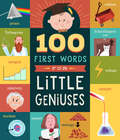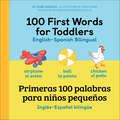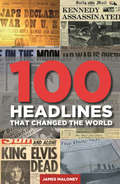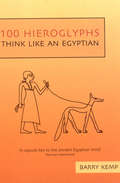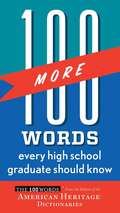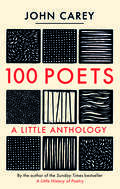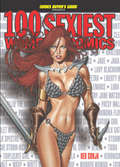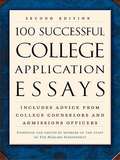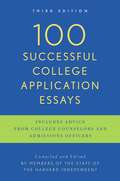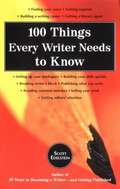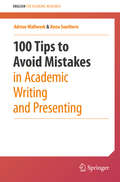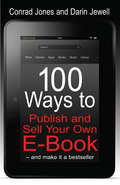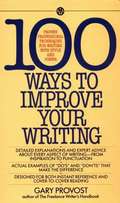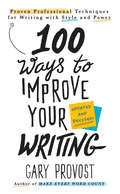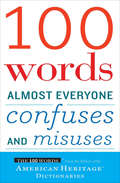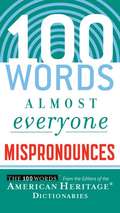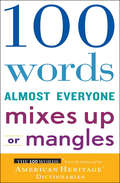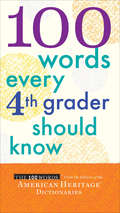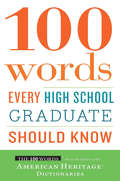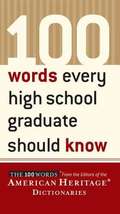- Table View
- List View
100 First Words for Little Californians (100 First Words)
by Ashley Marie MirelesCruising down the 5, rocking our Levis, and sipping a Cactus Cooler, we’re Californians, fosho. But, like, how do we pass these big California vibes on to baby? Eureka! Introducing 100 First Words for Little Californians, a state primer for kids learning their first words! Forget apple and dog. Little Californians are ready to move from ABC to PCH and other California-specific words like the Industry, traffic, and animal style (if you know, you know). Packed with hilarious illustrations and 100 words every Cali-born baby should know (before any others, of course), 100 First Words for Little Californians is the perfect board book for families who call California home.
100 First Words for Little Canadians (100 First Words)
by Pierre LamielleWe can see the aurora borealis from the backyard and the Rockies from the front porch. We can always go for pancakes and maple syrup or some ketchup chips. And we’ll watch the Stanley Cup playoffs no matter who’s playing! We’re Canadians, through and through. But what about the baby, eh? What do you know? Introducing 100 First Words for Little Canadians, a Great White North primer for kids learning their first words! Forget apple and dog. Little Canadians are ready to move from ABC to RCMP and other Canada-specific words like bakeapple, ogopogo, and Celine. Packed with hilarious illustrations and 100 words every Canadian baby should know (before any others, of course), 100 First Words for Little Canadians is the perfect board book for families who call Canada home.
100 First Words for Little Geeks (100 First Words)
by Brooke JordenThere's a TARDIS cookie jar in our kitchen. A Picard air freshener in our car. And we won't even mention Harry Potter in the bathroom. We're geeks and proud of it! But is there nothing for baby? Inconceivable! Introducing 100 First Words for Little Geeks, a deliciously nerdy primer for kids learning their first words! Forget apple and dog. Little geeks are ready for holy grail, warp core, and intergalactic catastrophe (okay, forget that last one, but they'll learn tribble and that's about the same thing). Packed with hilarious illustrations and 100 words every geek baby should know (before any others, of course), 100 First Words for Little Geeks is the perfect board book for geek families everywhere. Great Scott!
100 First Words for Little Geniuses (100 First Words #2)
by Tyler JordenAre you a theoretical physicist? An engineer? A mathematician? Then of course your baby will be a genius too. But where to begin? Introducing 100 First Words for Little Geniuses, a brainy primer for kids learning their first words! Forget apple and dog. Little geniuses are ready for quark, integral, and thermodynamics. From math to physics to philosophy, these are the words every budding genius needs in his or her vocabulary (even at the age of 2). Packed with fun illustrations and 100 words every genius baby should know, 100 First Words for Little Geniuses is the perfect board book for smart families everywhere.
100 First Words for Toddlers: English-Spanish Bilingual (100 First Words)
by Jayme YannuzziHelp little ones ages 0 to 3 expand their English and Spanish language skills Make it fun for your toddler to learn all kinds of new words in both English and Spanish. Taking them from "airplane" and "el avión" to "window" and "la ventana," this book allows children to build their understanding of both languages and discover new ways to communicate and express themselves.100 First words—Grow your toddler's vocabulary with a variety of everyday words, each presented in both English and Spanish.Adorable artwork—Engage young readers and help them better understand each word's meaning with large, colorful images.Teaching tips—Make learning even more effective with easy tips (in both languages) for getting toddlers to remember each word.Ayudemos a los pequeños de 0 a 3 años a ampliar sus destrezas de inglés y español Hagamos que el aprendizaje de toda clase de palabras nuevas en inglés y español sea divertido para los niños pequeños. Llevándolos desde "airplane" y "el avión" hasta "window" y "la ventana," este libro les permite a los pequeños mejorar su comprensión de ambos idiomas y descubrir maneras nuevas de comunicarse y expresarse.100 Primeras palabras—Amplíe el vocabulario de su niño o niña con una variedad de palabras comunes, presentadas en inglés y español.Magnífico trabajo de arte—Anime a los pequeños lectores y ayúdeles a entender mejor el significado de cada palabra a través de imágenes grandes y coloridas.Consejos de enseñanza—Haga que el aprendizaje sea aún más efectivo con simples consejos (en ambos idiomas) que ayuden a los niños a recordar cada palabra.
100 Headlines That Changed The World
by James MaloneyNewpapers are a form of instant history, capturing forever the awe and fascination that great historical events inspire. They are also an intriguing source to return to as they reveal the contemporary view of world-changing events, before it can be shaped by subsequent developments. While newspapers have been around for centuries, it was only when the Industrial Revolution encouraged mass production that newspapers with attention-grabbing banner headlines began to be commonplace. Now that newspapers seem to be in decline, we can look back at the period from the late 19th to early 21st century as the heyday of the newspaper, as well as a period in which the world changed beyond recognition.Journalist James Maloney details the stories behind the 100 most momentous headlines, including:Abraham Lincoln Assassinated in 1865.Jack the Ripper (1888).Boer War begins (11 Oct 1899). Russian Revolution (1917).Wall Street Crashes in 1929.Hitler Sweeps to Power' in 1933.Britain declares war with Germany 3 Sept 1939).Japan declares war on US/ Attack on Pearl Harbor (7 December 1941). Communist China founded by Mao Tse-tung (1 October 1949).Watson and Crick discover DNA structure (1953).Cuban missile crisis (1962). J.F. Kennedy Assassinated (22 Nov 1963).First man on the moon/Apollo 11 (21 July 1969).Scientists identify AIDS (1981). Chernobyl (April 26 1986).Mandela (age 75) freed from jail (1990). Death of Princess Diana (31 Aug 1997).911 terror attacks (2001).Saddam Hussein's capture (13 Dec 2003).Bin Laden Shot Dead. in 2011.Death of Steve Jobs/Apple (5 October 2011).
100 Headlines That Changed The World
by James MaloneyNewpapers are a form of instant history, capturing forever the awe and fascination that great historical events inspire. They are also an intriguing source to return to as they reveal the contemporary view of world-changing events, before it can be shaped by subsequent developments. While newspapers have been around for centuries, it was only when the Industrial Revolution encouraged mass production that newspapers with attention-grabbing banner headlines began to be commonplace. Now that newspapers seem to be in decline, we can look back at the period from the late 19th to early 21st century as the heyday of the newspaper, as well as a period in which the world changed beyond recognition.Journalist James Maloney details the stories behind the 100 most momentous headlines, including:Abraham Lincoln Assassinated in 1865.Jack the Ripper (1888).Boer War begins (11 Oct 1899). Russian Revolution (1917).Wall Street Crashes in 1929.Hitler Sweeps to Power' in 1933.Britain declares war with Germany 3 Sept 1939).Japan declares war on US/ Attack on Pearl Harbor (7 December 1941). Communist China founded by Mao Tse-tung (1 October 1949).Watson and Crick discover DNA structure (1953).Cuban missile crisis (1962). J.F. Kennedy Assassinated (22 Nov 1963).First man on the moon/Apollo 11 (21 July 1969).Scientists identify AIDS (1981). Chernobyl (April 26 1986).Mandela (age 75) freed from jail (1990). Death of Princess Diana (31 Aug 1997).911 terror attacks (2001).Saddam Hussein's capture (13 Dec 2003).Bin Laden Shot Dead. in 2011.Death of Steve Jobs/Apple (5 October 2011).
100 Hieroglyphs: Think Like an Egyptian
by Barry Kemp&“Written by the greatest living Egyptologist, this wonderful, fun, and short book will take you inside the heads of the ancient Egyptians.&”—Sarah Parcak, National Geographic Egyptian culture is divided from us by several millennia, a lost people and a dead language. We can discover much about this fascinating civilization from its physical remains, but perhaps the greatest insights into the Egyptian mind come from Egyptian hieroglyphs. They reveal the priorities, concerns and beliefs of the Egyptians—a whole worldview. Unlike the Western alphabet, which is an arbitrary set of symbols not anchored in reality, each Egyptian hieroglyph denotes a concept central to Egyptian thinking. The language and its written form are intimately bound up with the imaginative world of the Egyptians. Here, Barry Kemp presents 100 of the Egyptian hieroglyphs to provide access to this unique culture. Kemp takes us on a journey through the Egyptian mind, revealing not only aspects of day-to-day life in Ancient Egypt, but gradually building a picture of the historical and mythological references that were the cornerstones of Egyptian thought. This fascinating book helps us get inside a long-vanished world. &“A capsule key to the ancient Egyptian mind.&”—Dr. Norman Hammond, The Times &“Kemp uses 100 hieroglyphs as a springboard for discussion of a range of topics . . . This clever premise works well . . . [an] enjoyable and informative volume.&”—Times Higher Education Supplement &“This is most certainly a book that will challenge and reward.&”—New World
100 More Words Every High School Graduate Should Know
by Editors of the American Heritage DictionaryIdeal for juniors and seniors in high school as well as adults who want to see how their vocabulary skills stack up, 100 More Words Every High School Graduate Should Know includes one hundred words of varying degrees of difficulty, representing the kinds of words high school students encounter in their classes and on standardized tests. From alacrity to zygote, with stops along the way at eponymous and lambent, the words are invariably intriguing and useful. Each entry includes the definition, pronunciation, and etymology, and often one or more quotations showing how the word is used in context.
100 Poets: A Little Anthology
by John CareyA wonderfully readable anthology of our greatest poetry, chosen by the author of A Little History of Poetry"Does anyone know more about poetry than John Carey? Almost certainly not."—The Times A poem seems a fragile thing. Change a word and it is broken. But poems outlive empires and survive the devastation of conquests. Celebrated author John Carey here presents a uniquely valuable anthology of verse based on a simple principle: select the one-hundred greatest poets from across the centuries, and then choose their finest poems. Ranging from Homer and Sappho to Donne and Milton, Plath and Angelou, this is a delightful and accessible introduction to the very best that poetry can offer. Familiar favorites are nestled alongside marvelous new discoveries—all woven together with Carey&’s expert commentary. Particular attention is given to the works of female poets, like Christina Rossetti and Charlotte Mew. This is a personal guide to the poetry that shines brightest through the ages. Within its pages, readers will find treasured poems that remain with you for life.
100 Sexiest Women in Comics
by Brent FrankenhoffVa-Va-Voom! For decades, fans have known the secret identities and powers of the beautiful women found in the comic book universe. Now you can savor the visual delights of the 100 Sexiest Women of Comics. From Aspen and Catwoman to Sue Storm and Zatanna, we rank 'em-and tell you a bit about their comics careers in this eye-popping and revealing book. Face it, tiger-you just hit the jackpot!
100 Successful College Application Essays (Second Edition)
by Harvard IndependentThe largest collection of successful college application essays available in one volume. These are the essays that helped their authors gain admission to Harvard, Yale, Brown, Columbia, Wellesley, Colby, and other outstanding schools—followed by invaluable comments by experts in admissions, placement, and college counseling at some of the best learning institutions around the country. This helpful guide includes: 100 complete essays with professional commentary Examples of essays on common topics (family background, athletics, work experience), as well as the more offbeat Essays on the immigrant experience by foreign-born students A section of drawing and cartoon essays Insider advice from a Princeton dean of admissions A “What Not to Do” chapter from a top college counselor And more Compiled by members from The Harvard Independent, the weekly newsmagazine of Harvard University, this is an invaluable resource for students who want to write the best possible essay—and improve their chances of admission to the best possible school.
100 Successful College Application Essays: Third Edition
by The Harvard IndependentThe Largest Collection of Successful College Application Essays Available in One Volume These are the essays that helped their authors gain admission to Harvard, Yale, Brown, Columbia, Wellesley, Pomona, and other outstanding schools—followed by invaluable comments by experts in admissions, placement, and college counseling at some of the best learning institutions around the country. This helpful guide includes: 100 complete essays with professional commentary Examples of essays on common topics (family background, athletics, work experience), as well as the more offbeat Essays on the immigrant experience by foreign-born students A section of drawing and cartoon essays Insider advice from a Princeton Dean of Admission And more Compiled by members of The Harvard Independent, the weekly newsmagazine of Harvard University, this revised and updated edition is an invaluable resource for students who want to write the best possible essay—and improve their chances of admission to the best possible school.
100 Things Every Writer Needs to Know
by Scott EdelsteinWriter, editor, and literary agent Scott Edelstein has done it all--and now this industry insider brings his valuable secrets to both beginning and established writers. Covering everything from building writing skills to dealing with editors to starting a writing business, this all-important guide will get you started and point you in the right direction. With matter-of-fact advice and encouragement from an expert, you'll get the information, inspiration, and guidance you need to write your best and begin a successful writing career.
100 Tips to Avoid Mistakes in Academic Writing and Presenting (English for Academic Research)
by Adrian Wallwork Anna SouthernThis book contains one hundred typical mistakes relating to papers, proposals, oral presentations, and correspondence with editors (e.g. journal submissions), reviewers (rebuttal letters), and editing agencies.The book is primarily intended for non-native English speaking researchers. However, it is also useful for editing agencies in order to help new or inexperienced editors spot the kinds of mistakes they need to correct in order to ensure their clients successfully have their papers published. Each section of a paper is covered separately: titles and abstracts; introduction and literature review; methods, results and tables; discussion and conclusions.Teachers of English for Academic Purposes (EAP) will learn which areas of writing and grammar to focus on including readability, word order, sentence length, paragraphing, ambiguity and punctuation. The last section in the book highlights the key areas where presenters make the most mistakes in terms of the use of English.Other books in this series: English for Writing Research Papers English for Presentations at International Conferences English for Academic Research: Grammar, Usage and Style English for Academic Correspondence English for Academic CVs, Resumes, and Online Profiles English for Academic Research: Writing Exercises English for Academic Research: Grammar Exercises English for Academic Research: Vocabulary Exercises English for Academic Research: A Guide for Teachers
100 Ways To Publish and Sell Your Own Ebook
by Conrad Jones Darin JewellIf you've published an e-book, or are planning to do so, you'll need this essential guide. It provides expert advice on every step of the process, from production through to all-important promotion. To ensure your e-book reaches its intended audience, at the very least you have to: - design and format the cover a certain way - know your options in terms of publishing platforms and choose the right one for your book - price and promote it appropriately - know which social networking, bookmarking and cataloguing sites are best suited to showcase it. This book will give your e-book its best chance of becoming a best seller.
100 Ways To Publish and Sell Your Own Ebook
by Conrad Jones Darin JewellIf you've published an e-book, or are planning to do so, you'll need this essential guide. It provides expert advice on every step of the process, from production through to all-important promotion. To ensure your e-book reaches its intended audience, at the very least you have to: - design and format the cover a certain way - know your options in terms of publishing platforms and choose the right one for your book - price and promote it appropriately - know which social networking, bookmarking and cataloguing sites are best suited to showcase it. This book will give your e-book its best chance of becoming a best seller.
100 Ways to Improve Your Writing
by Gary ProvostThis is the one guide that anyone who writes--whether student, business person, or professional writer--should put on the desk beside pencil, pen, typewriter, or word processor. Filled with professional tips and a wealth of instructive examples, this valuable, easy-to-use handbook can help you solve any and all writing problems. <P><P> Advisory: Bookshare has learned that this book offers only partial accessibility. We have kept it in the collection because it is useful for some of our members. To explore further access options with us, please contact us through the Book Quality link on the right sidebar. Benetech is actively working on projects to improve accessibility issues such as these.
100 Ways to Improve Your Writing (Updated): Proven Professional Techniques for Writing with Style and Power
by Gary ProvostThe classic text on writing well, now refreshed and updated.This is the one guide that anyone who writes—whether student, businessperson, or professional writer—should keep on his or her desk. Filled with professional tips and a wealth of instructive examples, 100 Ways to Improve Your Writing can help solve any writing problem. In this compact, easy-to-use volume you'll find the eternal building blocks of good writing—from grammar and punctuation to topic sentences—as well as advice on challenges such as writer's block and creating a strong title. It is a must-have resource—perfect for reading cover to cover, or just for keeping on hand for instant reference—now updated and refreshed for the first time.
100 Words Almost Everyone Confuses and Misuses (100 Words)
by Editors of the American Heritage DictionariesAvoid vocabulary mistakes with this fun guide to tricky and troublesome words! With concise and authoritative usage notes from the editors of the American Heritage® Dictionaries, this guide explains common English-language errors—whether it&’s mixing up affect and effect; blatant and flagrant; or disinterested and uninterested, or stumbling over sound-alikes including discrete/discreet or principal/principle. Other notes tackle such classic irritants as hopefully, impact, and aggravate, as well as problematic words like peruse and presently. A great read for anyone who cares about getting it right, 100 Words Almost Everyone Confuses and Misuses can help keep writers and speakers on the up-and-up!
100 Words Almost Everyone Mispronounces
by American Heritage Dictionary EditorsThis latest installment in the bestselling 100 Word series settles the score on 100 controversies and misconceptions about words with difficult or slippery pronunciations.
100 Words Almost Everyone Mixes Up or Mangles (100 Words)
by Editors of the American Heritage DictionariesEliminate mistakes and improve your vocabulary with this engaging guide to the world&’s most misused words. Do you know your delegate from your relegate, your cachet from your cache? At one time or another we&’ve all suffered the embarrassment of having our remarks corrected by a family member, colleague, or stranger. 100 Words Almost Everyone Mixes Up or Mangles presents fifty pairs of words that people have trouble getting right and keeping straight—words that tend to get corrected when we&’re least expecting it. These words include near-synonyms—words with subtle but important distinctions in meaning—like baleful vs. baneful, and effectual vs. efficacious. Other pairings bring together notorious sound-alikes, like faze (bother) vs. phase (stage), pour (put in fluid) vs. pore (read closely), and waive (forgo) vs. wave (say hello). The book also addresses some classic spelling blunders and &“nonwords,&” like beyond the pail, full reign, injust, and inobstrusive. Each word has a definition and a pronunciation, and most have etymologies explaining the word&’s origin. The mix-ups themselves are described in fun-to-read notes that provide clear solutions to help readers avoid making needless, uncomfortable gaffes. 100 Words Almost Everyone Mixes Up or Mangles gives readers the chance to improve their command of words that are often heard but just as often misused.
100 Words Every 4th Grader Should Know (100 Words)
by Editors of the American Heritage DictionariesThis A-to-Z reference is a fun way for elementary-school kids to improve their vocabulary—and become better readers and writers. With 100 Words Every 4th Grader Should Know, parents and teachers can present new and challenging words that will prepare kids to excel in their classes and in their reading. From accommodate to zest, each entry includes the word&’s pronunciation, clear definitions of its various senses, and one or more short example sentences—along with longer quotations from such literary sources as The Hobbit and Island of the Blue Dolphins showing how the word is used in a broader context.
100 Words Every High School Graduate Should Know
by Editors of American Heritage DictionariesWhat should the vocabulary of a well-rounded high school graduate be like? These 100 words provide the starting point in answering that question. The list is representative of the words that serious students will encounter in their coursework and will come to use as adults, whether in conversation or while reading the daily newspaper. Each word is fully defined and shown in context with example sentences from well-known authors. 100 Words Every High School Graduate Should Know is a must-have for every grad, perfect for building vocabulary, quizzing friends and family -- and just having fun.
100 Words Every High School Graduate Should Know
by The Editors of the American Heritage DictionariesIn addition to carefully choosing a well-balanced mix of terms from A to Z, the book balances straightforward vocabulary entries, such as bellicose, loquacious, and vehement, with words chosen directly from the disciplines of learning, such as parabola and hypotenuse from mathematics, gerrymander and enfranchise from civics, and photosynthesis and hemoglobin from biology. As a result, students often have an easier time with the list than adults, especially if they've been paying attention in their classes! The book also offers exercises at the end of the text to assist in the incorporation of the words into one's active vocabulary.
